The first stop of the "Stop Nuclear Power! Baltic Sea Info Tour 2010" took place from June 21-24 in Mariehamn on the Ǻland islands, an autonomous province between Finland and Sweden. A few days before an anti-nuclear bike tour had started from Turku heading to Mariehamn and crossing the beautiful archipegalo of the Ǻland. Some of these activists stayed, some new arrived and the start of the infotour should be a mixture of lectures about the nuclear policy of Finland, practical workshops and a bike action in the center of Mariehamn.
Arrival in Mariehamn (June 22)
In the morning the bikers went to take a shower so they could be near people without causing environmental hazard. After breakfast the participants introduced themselves and we went through the programme of the stop on the Ǻland islands. Afterwards Falk Beyer introduced the "Baltic Sea Info Tour" officially and informed about the impacts of the nuclear facilities around the sea which is today the most radioactive sea in the world.
Then Ulla Klötzer gave a lecture about nuclear power in Finland. She has been involved on the issue since 1979. You can see the power point for more details.
First it was about the history of nuclear power building in Finland: At the moment there are 4 reactors, and the 5th under construction (Olkiluoto 3). If we look back to the history we can see 2001 as an important year, because the decision was made to allow research about final disposal of nuclear waste. At that time only 3 MPs voted against it, so the decision was a strong signal of support to the nuclear industry. And later, in 2002, the decision for building the 5th nuclear power plant was made.
The problems of the construction of the 5th power plant were another focus of this lecture - Olkiluoto 3 is far away from completion and much behind the schedule. And currently there is a fight between AREVA and TVO to be discussed in an international court to decide who will have to pay the cost of this delay.
Right now there are 3 applications of the nuclear industry for new reactors. On 1st of July the Finnish parliament will decide about the proposal of the government to approve the applications of Fennovoima (EON!) and TVO.
Fennovoima is a coalition of the German company E-on and Finnish companies, for example big grocery stores. So it is difficult to boycott Fennovoima, as it means we hardly could buy anby food! But it is important to know that - similar to many other countries - most of the Finns are against nuclear energy. It is only the media and the politicians that are pushing towards a nuclear Finland.
In Finland the nuclear industry and the government are planning to finish the first final repository for high level radioactive waste in the world. The method is similar to the Swedish model. The basic plans for this method of final disposal is from the 1970s, but the pro-nuclear lobby says the safety would be guaranteed for 10,000 years. This is the opposite of what independent scientists say.
Activists in Finland are fighting to let the country not become a playground of AREVA and other nuclear companies. These companies want to mine uranium in Finland, generate nuclear power for the European market and leave the region with the waste which is hazardous for a longer time than human beings can imagine.
Challenges in the Campaign Against Nuclear Power
In the evening we attended the talk "Challenges in the Campaign Against Nuclear Power" given by Ulla Klötzer in the library in Mariehamn. This was a public event with around 20 Ålandic people in addition to people from the tour.
Some of the content was familiar from her talk to the tour participants in the morning – the basic context, the papers published by Sitra (an official think tank in Finland) in the mid 1990s outlining three possible future development routes for Finland of which one, nuclear Finland, is remarkably similar to the current direction and what is know about how the Parliament will vote. She went in to a bit more detail on the conflict of interest in which the senior civil servant in the industry ministry finds himself and the governments attempt to get around it. She also gave more detail on the conflict between the current expansion of nuclear power in Finland for export and the government's climate strategy from 2008, approved by the parliament, which allows nuclear power for domestic needs but not for export.
Also covered was the problems with the safety systems in the EPR design (now being built at Olkiluoto) and the cost overruns of that project (and the unrealistic nature of the initial cost estimates). The financing of Olkiluto 3 was explained as was the nature of the jobs created (only max 1/3 Finnish and many very low paid and poor conditions due to the subcontracting arrangements) and the various problems which have beset the project.
Turning to the proposals for new nuclear plants she presented opinion poll data showing that while politicians, industry and the trade unions may be largely in favour of an expansion of nuclear power, the Finnish population is not. She also presented financial analyses, including one from Citigroup, indicating that unsubsidised nuclear power is not economically feasible and current cost estimates are much too low. Special attention was paid to the problems with the Fennovoima application with one of the proposed sites being a nature area and the other too populated (3,000 people plus a harbour and factories within the 5-6 km area which according to Finnish law should be home to maximum 200 people) while Fennovoima has no idea how to deal with it's nuclear waste or where to put it.
She then presented the nuclear plants around the baltic and the population centres at risk from each.
Who bears financial responsibility for the consequences of a nuclear accident was also discussed. The Finnish Parliament passed a new law in 2005 but the government has so far failed to bring it into force. The uninsurability of nuclear power plants if they are to bear the full costs of an accident was illustrated by looking at the example of the Chernobyl disaster.
The status of, and problems with, plans for final repositories for spent nuclear fuel in Finland and Sweden were also covered with reference to the risk of Finland ending up taking other countries waste as well as its own.
Finally she presented some of the problems associated with uranium mining, illustrated with pictures from French and Canadian uranium mines. Also discussed here was other consequences of uranium extraction, such as the use of depleted uranium to make weapons and the consequences observed in Iraq from such weapons.
Following the presentation Ulla Klötzer answered questions and there was a public discussion of some of the issues raised and what we could do about them.
Bike Action Against Nuclear Power (June 23)
Local anti-nuclear activists organized together with Baltic Sea Info Tour participants a demonstration on June 23 in the center of Mariehamn. The demonstration was held to promote the "Vote nuclear power to history"-campaign and to demand Åland's MP Nauclér to bring up the unsolved nuclear waste issue in the Finnish parliament just before the parliament will vote about building new nuclear reactors.
A line of 20 people on bicycles and by feet left at 11 AM from the youth house Uncan and drove around on the streets of the city centre stopping on the way on the market square and in the pedestrian precinct to give out anti-nuclear flyers. The campaign asks people to announce that in the next parliament elections they won't vote for a person who have said "yes" to the government's proposal to build more nuclear reactors.
We reached some 300 people with our banners and flyers on a busy lunch hour on the streets of the centre.
A part of the group continued the demonstration on a Viking Line ferry from Mariehamn to Turku. The group of four activists handed out flyers of the upcoming Olkiluoto blockade and the Nuclear Baltic Sea Info Tour to the passengers of the ferry who seemed to be genuinely interested of the nuclear situation in Finland and Sweden.
Åland in the shadow of nuclear power
Adam Conway, an Ålandic activist and organizer gave this lecture about the impacts of the nuclear industry around the northern part of the Baltic Sea to the autonomous and (officially) nuclear free region Åland. The islands archipegalo is situated in the middle of the Baltic Sea between Sweden and Finland. There are no nuclear power plants on Åland, but within a radius of 100 km from Åland there are 5 nuclear power plants in operation, two repositories for low and medium level radioactive waste already in usage and plans for two final reposities for high-level nuclear waste, as well as one reactor under construction and plans for another new one.
We discussed also the political process with these planned final repositories, in Olkiluoto in Finland and in Forsmark in Sweden. Both countries are using the Swedish model for final disposal. The procedures in Finland and in Sweden are very different. While in Finland it is supposed to have almost no discussion about the whole issue, in Sweden the whole process has been much more open and the environmental organisations have received financial support from the "nuclear waste fund" to follow the issue.
There is much evidence that this disposal method can't provide safety. For example, the copper can corrode and the fact that all three barriers, that are supposed to prevent the radioactive waste from leaking out, are based on each other and can not work independently. The highly radioactive waste will be put into the wet rock formation full of gaps. In a depth of 400-500 m the containers that will be wrapped by a thin layer of 5 cm of copper will be surrounded by bentonite clay. This method is called KBS-3 method.
Outlook
On Friday June 25 the infotour will stop in the region of the Loviisa NPP in southern Finland. Friday night there will be an anti-nuclear Midsummer party in Isnäs, Saturday will be open for practical workshops and discussions, on Sunday a regional network gathering will take place and Monday is action day in Loviisa as well as an information event about the nuclear waste final disposal challenges will take place in the evening in Isnäs.
Between June 30 and July 2 the Baltic Sea Info Tour will stop in Helsinki, do some programme and many actions, events and theatre performances around the day of the parliament's vote about future construction plans for nuclear reactors. Afterwards the next stops will be in St. Petersburg, Riga, Belarus and Vilnius. This is still not the end as the tour continues around the whole Baltic Sea to arrive eventually in the North of Finland in the middle of August. Check the Infotour website to find out more!

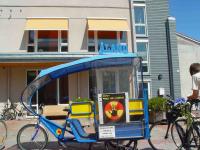
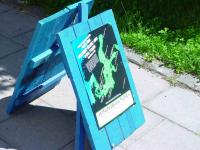
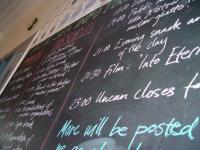
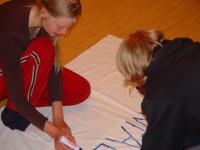
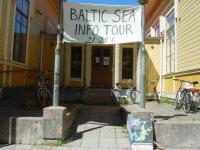
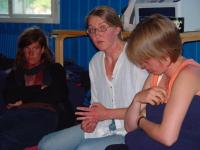

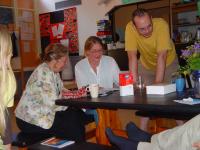
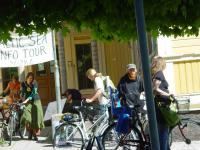
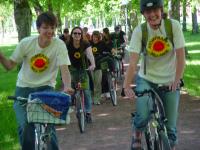
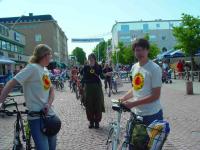
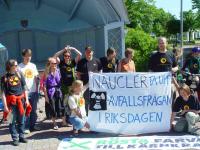
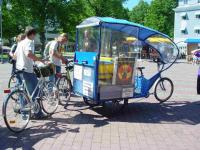
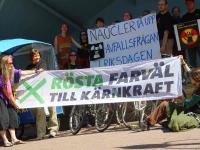
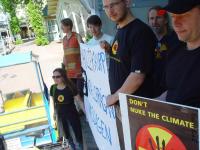
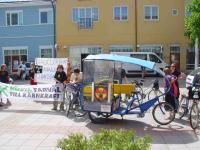
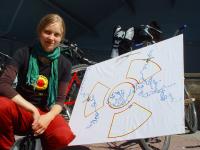
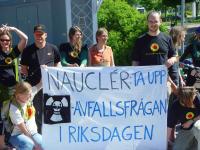
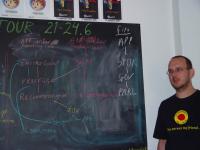
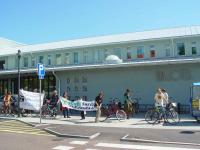
Atomic Death in Riga
http://linksunten.indymedia.org/de/node/23051
Anti-nuclear Stop in St. Petersburg
http://linksunten.indymedia.org/de/node/23691
Introduction to the Infotour
German:
http://linksunten.indymedia.org/de/node/21640
English:
http://linksunten.indymedia.org/en/node/21841
Anti-nuclear Stop in Lithuania
http://linksunten.indymedia.org/en/node/23669